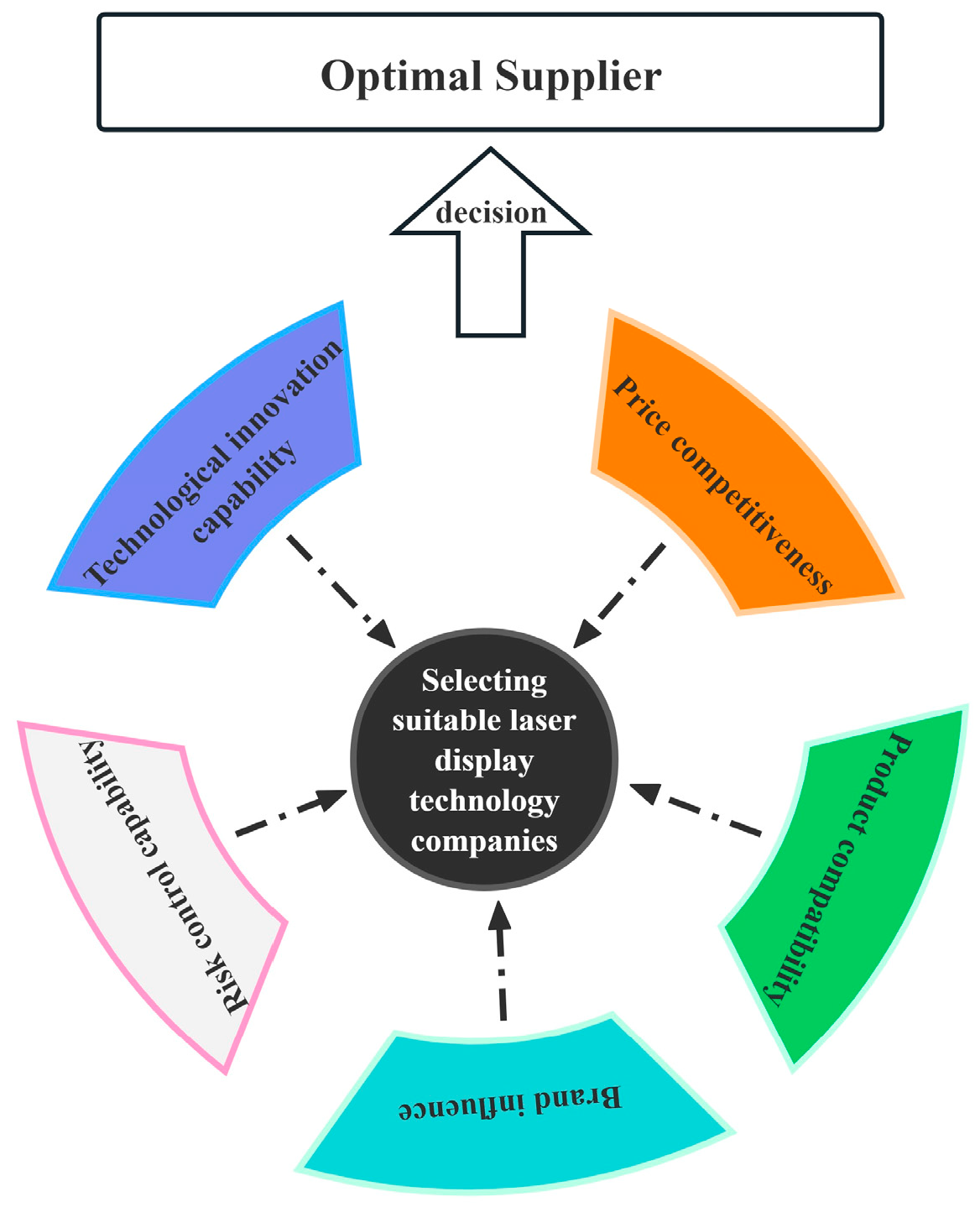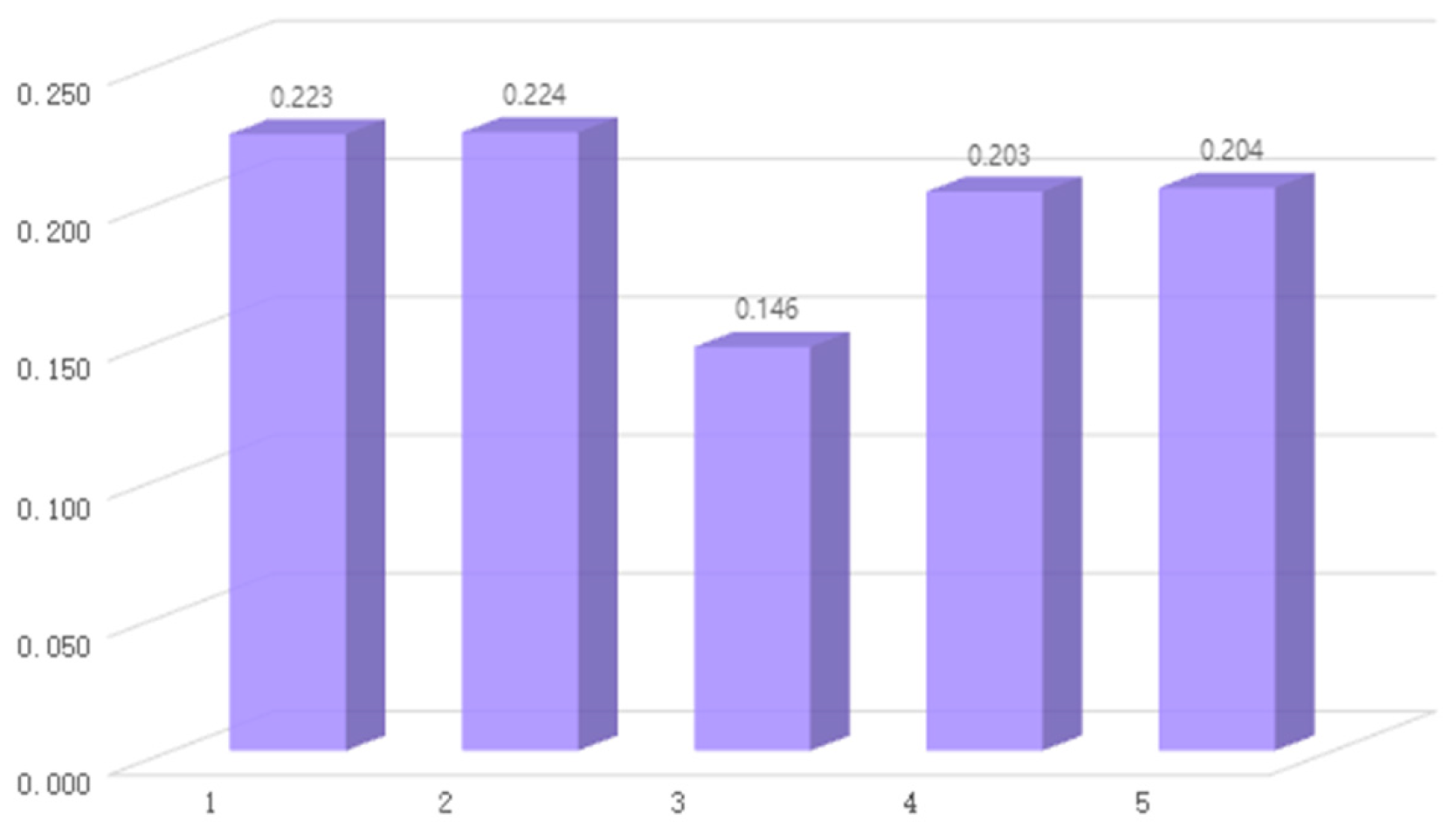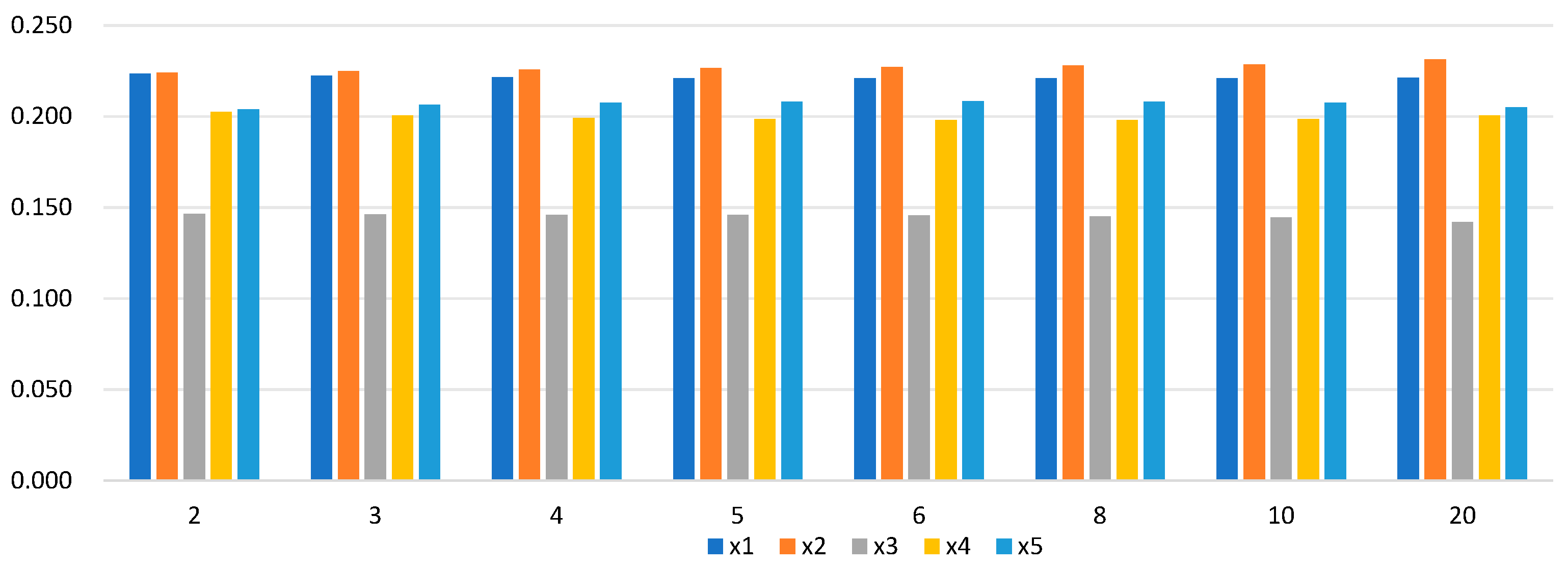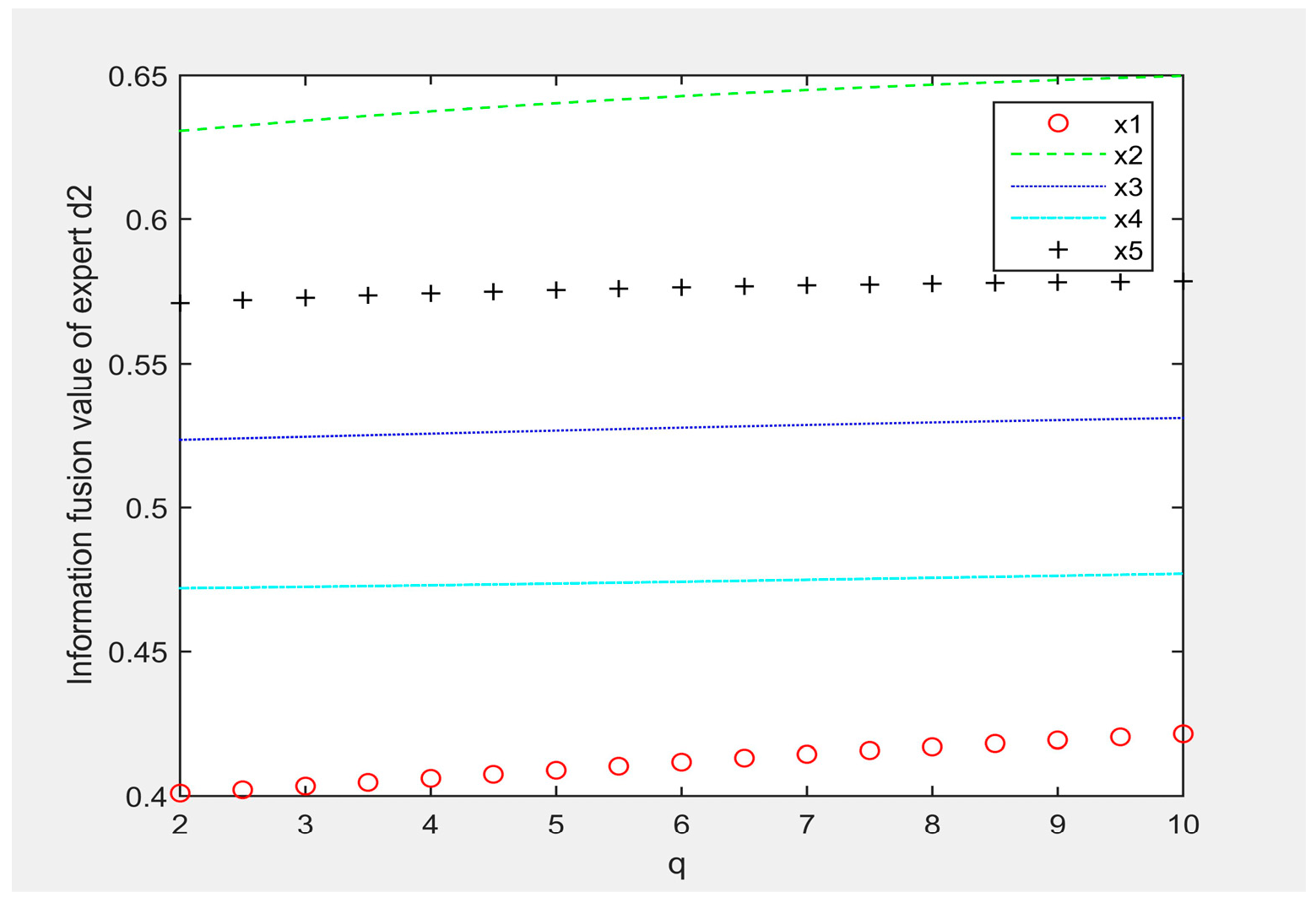1. Introduction
Under the backdrop of global economic integration, globally diversified procurement helps enterprises to quickly, flexibly, and efficiently meet the needs of downstream customers at a lower cost. Procurement strategies can be categorized into single-source and multi-source procurement based on the number of suppliers. Multi-source procurement reduces dependency on individual suppliers, mitigates supply risks, and fosters competition among suppliers to secure better pricing and services. For example, industries such as power generation, automotive parts, agricultural commodities, electronic components, and other highly standardized products typically adopt multi-source procurement strategies. It is essential for enterprises to select suppliers scientifically. In earlier research, supplier evaluation primarily focused on economic performance. With the emergence and evolution of the concept of sustainable development, the supplier evaluation system has gradually incorporated a comprehensive set of indicators, including economic, environmental, and social performance. However, due to the limitations of individual decision-makers’ knowledge and expertise, it is difficult to conduct a comprehensive and balanced assessment when dealing with such complex decision-making problems. This necessitates collaboration among multiple decision-makers to combine their collective wisdom.
Therefore, multi-attribute group decision-making (MAGDM) is one of the main approaches for addressing supplier selection problems. Whether the evaluation value of indicators can accurately express the preferences of decision experts is a key factor in determining the accuracy of decision models. Fuzzy set theory is an efficient information modeling tool with high information richness and flexibility, widely used in different decision-making fields, such as security risk assessment [
1], charging station location selection [
2], infectious disease hospital location selection [
3], project investment risk assessment [
4], new energy vehicle battery recycling [
5], supplier selection [
6], enterprise selection of cost-effective production plans [
7], dengue fever prevention and control strategy selection [
8], and medical service quality evaluation during epidemics [
9].
Smarandache proposed Neutrosophic Set (NS) [
10], which has been widely studied over the past few decades [
11,
12,
13,
14]. For the convenience of information modeling, Wang further proposed the single-valued neutrosophic set (SVNS), which consists of truth membership function (TMF), indeterminacy membership function (IMF), and falsity membership function (FMF) [
15]. The constraint conditions for SVNS are
. However, in NS and SVNS, TMF, IMF, and FMF are assumed to be mutually independent. In 2016, Smarandache further discussed the NS, where TMF, IMF, and FMF have interdependent relationships [
16]. The semi-dependent NS has attracted the attention of many scholars. Monoranjan and Madhumangal provided the intuitionistic neutrosophic set (INS) in the case where TMF and FMF are dependent intuitionistic fuzzy (IF) numbers, and
[
17]. Jansi et al. provided the Pythagorean neutrosophic set (PNS) under the condition where TMF and FMF are interdependent Pythagorean fuzzy (PF) numbers, and
[
18]. PNS has significantly expanded the application scope of semi-dependent NS, but it still falls short of being sufficiently broad. For example, when a decision-making expert evaluates a certain attribute, they consider the TMF and FMF to be 50% dependent on each other, with the values of the TMF, IMF, and FMF being 0.7, 0.8, and 0.8, respectively. Despite
, since
, the condition that TMF and FMF are dependent in a Pythagorean fuzzy relationship is therefore not satisfied. Drawing on the information modeling method of q-rung orthopair fuzzy sets, which enhances the model’s capability by increasing the value of the exponent. As shown in
Figure 1, the information modeling capability is significantly enhanced as q increases. For example, if the exponent is 3,
,
. This indicates that TMF and FMF exhibit a three-rung orthopair fuzzy dependence.
To evaluate big data capabilities in manufacturing supply chains, Feng et al. developed a MAGDM model based on Pythagorean fuzzy sets [
19]. Choudhary et al. proposed an intuitionistic fuzzy supply chain evaluation model from the perspective of sustainable development capacity [
20]. Pamucar et al. defined neutrosophic information aggregation operators under Dombi norms and applied them to solve multi-attribute decision-making problems for supplier selection [
21]. Priyadharshini et al. investigated the green supplier selection problem under a complex neutrosophic fuzzy environment and proposed a MAGDM method based on Schweizer–Sklar operators [
22]. Riaz et al. utilized q-rung orthopair fuzzy sets to represent supplier evaluation information and developed a MAGDM method with prioritized aggregation operators, which was applied to baby crib supplier selection [
23]. All the above studies assume that the membership degree, non-membership degree, and other indicators of evaluation information are independent of each other. However, in complex fuzzy environments, decision-makers’ cognitive and emotional biases often make it difficult to provide completely independent assessment information. Furthermore, evidence theory is an effective tool for handling uncertainty and conflict in information, yet it has been rarely used in existing group decision-making models, especially in the context of supply chain management problems.
The motivation of this study stems from enhancing the information modeling capability of existing semi-dependent fuzzy sets and enriching the theoretical framework for group decision-making in supplier selection problems. The main contributions of this paper are as follows:
Proposes a broader semi-dependent fuzzy set QTSDNS, which is the general form of PNS, INS, IF set, PF set, q-type orthopair fuzzy set, and so on;
Operational rules and information fusion operators for q-type semi-dependent neutrosophic numbers have been developed, facilitating the application of QTSDNS in practical decision-making models with semi-dependent characteristics;
An evidence-based information fusion method for q-type semi-dependent neutrosophic numbers is proposed;
A q-type semi-dependent group decision-making algorithm was proposed based on evidence theory and the developed operators. This method was applied to solve a supplier selection problem in the intelligent vehicle industry, thereby extending the scope of research on fuzzy supplier selection. The decision-making method proposed in this paper has a wide range of application scenarios and can be extended to decision-making fields such as human resource recruitment, investment project selection, green building scheme selection, and medical scheme selection.
The remainder of this paper is structured as follows: In
Section 2, we review evidence theory and introduce the concept and operational rules of QTSDNS. In
Section 3, a q-TSDNWAA operator and a q-TSDNWGA operator are developed. In
Section 4, a group decision-making algorithm is proposed, combining the evidence information fusion method for q-type semi-dependent neutrosophic numbers and the q-TSDNWAA (or q-TSDNWGA) operator. In
Section 5 and
Section 6, through a simulation experiment involving the selection of radar and laser display suppliers for intelligent automobiles, the effectiveness of the algorithm presented in this article is demonstrated, and the impact of parameters on the group decision-making model is analyzed. A comparative study is conducted in
Section 7. Finally, in
Section 8, a summary and outlook are provided for the research work on q-type semi-dependent neutrosophic numbers conducted in this article.
3. Aggregation Operators for QTSDNNs
Here, we will define and discuss the semi-dependent operators.
Definition 8. Let be a collection of QTSDNNs with the weight . Then, the q-TSDNWAA operator is defined as q-TSDNWAA .
Theorem 2. Let be a collection of QTSDNNs with the weight . Then Proof. For , then we get
q-TSDNWAA
. □
When
,
suppose that
Then , we have,
q-TSDNWAA
.
So, Equation (1) is true for all n.
Theorem 3 (Idempotency). Let
be a collection of QTSDNNs with the weight
. If Proof. q-TSDNWAA
. □
Theorem 4 (Idempotency). Let be two collection of QTSDNNs with the same weight . If , then Proof. For any i, Hence, .
and
.
.
.
q-TSDNWAA
.
q-TSDNWAA
.
Theorem 5 (Boundedness). Let be a collection of QTSDNNs with the weigh t
. If and then Proof. Since
.
.
.
.
q-TSDNWAA
. □
Definition 9. Let
be a collection of QTSDNNs with the weight
. Then, the q-TSDNWGA operator is defined as Theorem 6. Let be a collection of QTSDNNs with the weight . Then Proof. For
, then we get
q-TSDNWGA
. □
When
,
suppose that
Then
, we have,
So, Equation (5) is true for all n.
Theorem 7 (Idempotency). Let be a collection of QTSDNNs with the weight . If , then Proof. q-TSDNWGA
. □
Theorem 8 (Idempotency). Let be two collection of QTSDNNs with the same weight . If , then Proof. For any i,
Hence,
and
.
.
.
.
.
q-TSDNWGA
q-TSDNWGA
. □
Theorem 9 (Boundedness). Let be a collection of QTSDNNs with the weight
. If Proof. Since
,
,
and
q-TSDNWGA
. □
Example 1. Assume that
,, are three QTSDNNs with the weight vector of
. The following aggregation is performed using the q-TSDNWAA and q-TSDNWGA operators, respectively. Using the q-TSDNWAA operator (here, q = 2), the calculation process is as follows. Using the q-TSDNWGA operator (here, q = 2), the calculation process is as follows.
As shown in
Figure 2, under identical parameters, the aggregated value score derived from the q-TSDNWAA operator significantly differs from that of the q-TSDNWGA operator. Specifically, the q-TSDNWAA operator yields a higher score than the q-TSDNWGA operator. Consequently, during aggregation, optimistic decision-makers may prefer the q-TSDNWAA operator, whereas pessimistic ones may opt for the q-TSDNWGA operator. This divergence stems from their fundamental construction principles: The q-TSDNWAA operator employs an arithmetic mean-based approach, demonstrating strong compensability (where high values in one attribute can offset low values in others). The q-TSDNWGA operator utilizes a geometric mean-based approach, emphasizing synergistic effects among attributes.
4. MAGDM Using QTSDNN
In this section, we will combine evidence theory with the operators proposed earlier (q-TSDNWAA operator and q-TSDNWGA operator) to present a decision framework for q-type semi-dependent neutrosophic MAGDM problems.
Let
be a set of alternatives,
be the attributes, and
be the weights of alternatives,
,
, and
be a set of experts.
, where
denotes the QTSDNN of
under
provided by expert
. The q-type semi-dependent neutrosophic decision matrix
by expert
is defined as
Step 1. Transform the q-type semi-dependent neutrosophic decision matrix
into a normalized matrix
, where
Step 2. Integrate the kth line of
by the q-TSDNWAA (or q-TSDNW-GA) operator, and get the information fusion matrix
of expert
, where
q-TSDNWAA
,
;
or
q-TSDNWGA
,
;
.
Step 3. Transform the information fusion matrix
into a standardized matrix
, where
Step 4. Based on the definition of QTSDNN, we consider the individual integrated information as evidence information. QTSDNN can be regarded as containing three types of information: the complete acceptance of the attributes of candidate solutions (accept), the complete disapproval (reject), and the hesitation between acceptance and disapproval (accept, reject). According to the Evidence theory, the complete set can be defined
{accept, reject}. So, the power set
is
{accept},{reject},{accept, reject
. The BPA can be defined
,
m({accept}),
m({reject}),
m({accept, reject}). F or
, by referring to references [
1,
2,
3], it can be considered that
Using the evidence combination formula
where
accept, reject, (accept, reject)}, we obtain the group evidence information
of
,
.
Step 5. Based on the group evidence information
, calculate the group trust interval
for alternatives, where
[Bel
, Pl
],
.
Step 6. Calculate the possibility matrix
, where
Step 7. If
, where
,
then the optimal alternative is
[
27].
Figure 3 presents the detailed workflow of the proposed methodology described in the algorithm above.
5. Illustrative Example
In this section, an investment appraisal project is employed to demonstrate the application of the proposed decision-making approach, as well as the validity and effectiveness of the proposed approach. The Chinese auto market, as one of the largest and most innovative strategic areas globally, is fully embracing intelligent transformation. As a key element for achieving differentiation in smart vehicles, the smart cockpit has become a highly sought-after area in the automotive industry. This trend generates new demands for in-vehicle optics and stimulates innovative applications of laser technology in this field. With the development of intelligent vehicles, there has been a notable increase in industrial cooperation, with deep collaboration between automotive companies and tech firms. Some car manufacturers prefer to choose partners with global advantages to provide smart vehicle solutions. Therefore, in the field of smart cockpits, selecting suitable laser display technology companies for collaboration will be a focus and challenge for automotive enterprises. A certain automotive company, after thorough market research and analysis, selected five technology companies {
x1,
x2,
x3,
x4,
x5} as potential partners for optimal collaboration. Given the complexity of the corporate project, three decision-making experts {e1, e2, e3} were invited to conduct a comprehensive assessment. The experts used fuzzy sets as a tool to represent evaluation information, evaluating the five technology companies across five dimensions, which are shown in
Figure 4 (the weighting vector is
w = (0.15, 0.25, 0.25, 0.15, 0.2)
T):
—Price competitiveness: Supply chain cost control is an effective means for enterprises to achieve cost management, enabling them to plan and utilize various resources rationally during production and operations. Effective control of the cost prices of automotive parts directly affects the price competitiveness of the enterprise’s smart automobile products in the market.
—Technological innovation capability: Products with technological innovation capability can increase their appeal, making consumers more eager to purchase them. In the increasingly competitive market environment, continuously advancing technological innovation and selecting components with technological innovation capability in supply chain procurement to enhance the technological content of products are of significant importance for enterprises to build new competitive advantages and promote healthy development.
—Risk control capability: Risk management capability provides systematic assistance for enterprises to identify, evaluate, and respond to potential risks, helping them to make reasonable decisions in the face of uncertainty. Selecting suppliers with high risk-management capabilities as partners can secure sustainable partnerships, thereby providing long-term assurance for the maintenance and repair of components in the future.
—Brand influence: Parts suppliers with strong social influence typically have a good brand image and reputation, which can help to enhance the brand image of automotive manufacturers. Furthermore, a good reputation among parts suppliers can reduce the risk of negative news, thereby protecting the brand value of smart automobile manufacturers.
—Product compatibility: Selecting parts suppliers with compatibility is crucial for improving the production efficiency of automotive manufacturers, enhancing product quality, and maintaining market competitiveness. For example, parts with strong compatibility can simplify the design and manufacturing processes of vehicles, reducing the time and costs required for additional design or adjustments due to mismatched parts.
They provided pairwise comparisons for these companies and gave their decision information matrices in the form of QTSDNNs, as shown in
Table 2,
Table 3 and
Table 4.
The following will use the q-type semi-dependent neutrosophic model proposed in this article to address the issue of selecting laser display partners for intelligent automotive enterprises. The steps are as follows:
Step 1. Normalize the decision matrix. Since the five criteria—price competitiveness, technological innovation capability, risk control capability, brand influence, and product compatibility—are all benefit-oriented, therefore
.
Step 2. Integrate the kth line of
by the q-TSDNWAA operator (q = 2), and get the information fusion matrix
.
Similarly, the information fusion matrix can be calculated as detailed in
Table 5.
Step 3. The information fusion matrix is standardized, and the detailed results are presented in
Table 6.
Step 4. Obtain group evidence information
of
,
,
,
,
.
Step 5. Calculate the group trust interval
,
.
,
,
,
,
.
Step 6. Calculate the possibility matrix
.
Step 7. Calculate the ranking vector and give the best choice.
Since
, it can be clearly seen from
Figure 5 that the optimal alternative is
.













